Starting with zero commissions, thriving in the crypto boom.
Written by: Yanz, Liam
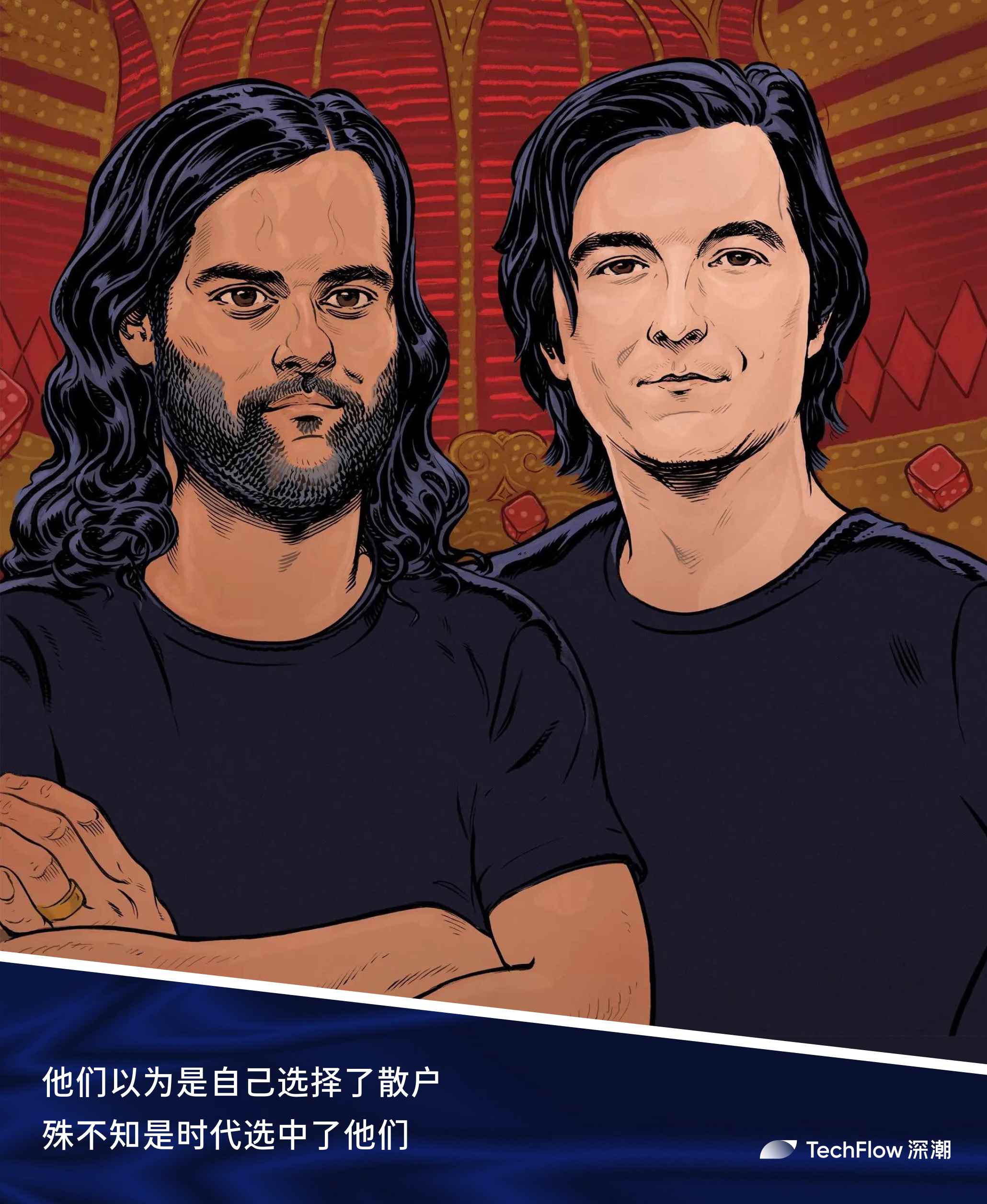
"A good financial person, 'the Robin Hood' of finance," a friend once described Vladimir Tenev.
Later, this nickname became the name of a company that changed the financial industry. However, this was not the beginning of the entire story.
Vladimir Tenev and Baiju Bhatt, the two founders with backgrounds in mathematics and physics from Stanford University, met during a summer research project while undergraduates at Stanford.
Neither of them anticipated that they would become deeply intertwined with a generation of retail investors; they thought they chose retail investors, but in reality, it was the times that chose them.

During his time at Stanford, Tenev began to question the prospects of mathematical research. He grew tired of the academic life of "spending years studying a problem, only to end up with nothing," and could not understand why his PhD classmates were willing to toil for meager incomes. This reflection on traditional paths quietly planted the seeds for his entrepreneurial journey.
In the fall of 2011, coinciding with the peak of the "Occupy Wall Street" movement, public dissatisfaction with the financial industry reached its zenith. In Zuccotti Park in New York, tents of protesters were scattered everywhere, and even from their office window in San Francisco, Tenev and Bhatt could see the aftermath of this scene.
That same year, they founded a company called Chronos Research in New York, developing high-frequency trading software for financial institutions.
However, they soon realized that traditional brokers kept ordinary investors out of the financial markets with high commissions and complicated trading rules. This led them to ponder: Can technology that serves institutions also serve retail investors?
At that time, new mobile internet companies like Uber, Instagram, and Foursquare were emerging, and products designed specifically for mobile began to lead the trend. In contrast, the financial industry had low-cost brokers like E-Trade that still struggled to adapt to mobile devices.
Tenev and Bhatt decided to ride the wave of technology and consumerism, transforming Chronos into a free stock trading platform aimed at millennials and applying for a brokerage license.
Millennials, the internet, and free trading—Robinhood gathered the three most disruptive elements of this era.
At that time, they did not foresee that this decision would open the door to an extraordinary decade for Robinhood.
Targeting Millennials
Robinhood set its sights on a blue ocean market that was overlooked by traditional brokers—millennials.
A survey conducted by traditional financial firm Charles Schwab in 2018 showed that 31% of investors compared fees when choosing brokerage firms. Millennials were particularly sensitive to "zero fees," with over half of respondents indicating they would switch to a more price-advantageous platform for this reason.
Zero-commission trading emerged against this backdrop. At the time, traditional brokers typically charged $8 to $10 per trade, while Robinhood completely eliminated this fee and set no minimum account balance requirement. The model allowing trades for as little as one dollar quickly attracted a large number of novice investors, and combined with a simple, intuitive, and even "game-like" interface design, Robinhood successfully increased user trading activity and even cultivated a group of "addicted traders" among young users.
This transformation in the fee model ultimately forced the industry to adapt. In October 2019, Fidelity, Charles Schwab, and E-Trade successively announced they would reduce trading commissions to zero. Robinhood became the "first" to carry the banner of zero commissions.

Source: Dongfang Securities
Adopting the Material Design style launched by Google in 2014, Robinhood's gamified interface design even won an Apple Design Award, becoming the first fintech company to receive such an honor.
This was part of the success, but not the most critical aspect.
In an interview, Tenev described the company's philosophy by quoting a line from the movie "Wall Street" spoken by the character Gordon Gekko: "The most important commodity that I have is information."
This statement encapsulated the core of Robinhood's business model—Payment for Order Flow (PFOF).
Like many internet platforms, Robinhood's seemingly "free" service actually comes at a higher cost.
It profits by selling users' trading order flow to market makers, but users may not necessarily get the best market price, believing they are benefiting from zero-commission trading.
In simple terms, when users place orders on Robinhood, these orders are not sent directly to the public market (like NASDAQ or the NYSE) for execution; instead, they are first forwarded to market makers (such as Citadel Securities) that partner with Robinhood. These market makers profit by executing buy and sell orders at very small price differences (usually a fraction of a cent). In return, market makers pay Robinhood "order flow payments."
In other words, Robinhood's free trading actually makes money in "invisible" ways to the user.
Despite founder Tenev repeatedly claiming that PFOF is not a source of profit for Robinhood, the reality is that in 2020, 75% of Robinhood's revenue came from trading-related businesses, and by the first quarter of 2021, this figure rose to 80.5%. Even though the proportion has slightly decreased in recent years, PFOF remains an important pillar of Robinhood's revenue.
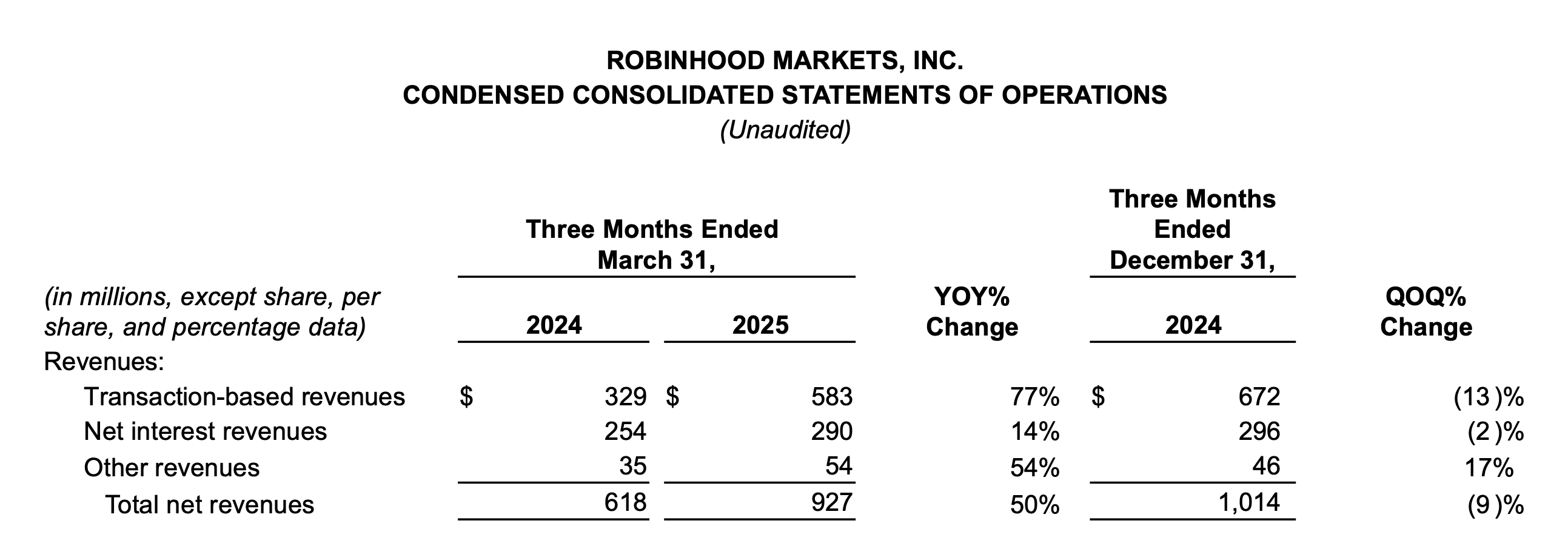
Adam Alter, a marketing professor at New York University, bluntly stated in an interview: "For a company like Robinhood, simply having users is not enough. You must keep them clicking the 'buy' or 'sell' buttons, lowering all the barriers people might encounter when making financial decisions."
Sometimes, this extreme experience of "lowering barriers" brings not only convenience but also potential risks.
In March 2020, a 20-year-old American college student named Kearns, after trading options on Robinhood, discovered that his account showed a loss of up to $730,000—far exceeding his $16,000 principal. This young man ultimately chose to take his own life, leaving a note for his family that read: "If you are reading this letter, I am no longer here. Why can a 20-year-old with no income use nearly $1 million in leverage?"
Robinhood precisely hit the psychological needs of young retail investors: low barriers, gamification, and social attributes, and enjoyed the returns brought by this design. As of March 2025, the average age of Robinhood users remained stable at around 35 years.
But everything that fate bestows comes with a price tag, and Robinhood is no exception.
Robin Hood, robbing the rich to help the poor?
From 2015 to 2021, the number of registered users on the Robinhood platform grew by 75%.
Especially in 2020, alongside the COVID-19 pandemic, U.S. government stimulus policies, and a nationwide investment craze, both the number of platform users and trading volume soared, with managed assets once exceeding $135 billion.

The surge in users was accompanied by a wave of disputes.
At the end of 2020, the Massachusetts Securities Division accused Robinhood of attracting inexperienced users through "gamification" while failing to provide necessary risk controls during market volatility. Shortly thereafter, the U.S. Securities and Exchange Commission (SEC) also launched an investigation into Robinhood, accusing it of failing to secure the best trading prices for users.
Ultimately, Robinhood chose to pay $65 million to settle with the SEC. The SEC pointed out that even considering the commission-free advantage, users still lost a total of $34.1 million due to price disadvantages. Robinhood denied the allegations, but this controversy was destined to be just the beginning.
What truly embroiled Robinhood in a whirlpool of public opinion was the GameStop incident in early 2021.
The video game retailer, which holds childhood memories for a generation of Americans, fell into trouble due to the pandemic and became a target for institutional investors to short sell. However, thousands of retail investors were unwilling to watch GameStop be crushed by capital. They gathered on the Reddit forum WallStreetBets, collectively buying shares using trading platforms like Robinhood, sparking a "retail investor short squeeze" battle.
GameStop's stock price skyrocketed from $19.95 on January 12 to $483 on January 28, an increase of over 2300%. A financial frenzy of "grassroots resistance against Wall Street" shook the traditional financial system.
However, this seemingly victorious moment for retail investors quickly turned into Robinhood's "darkest hour."
The financial infrastructure of that year simply could not withstand the sudden surge in trading. According to the settlement rules at the time, stock trades required T+2 days to complete clearing, and brokers had to pre-allocate risk margins for user trades. The surge in trading volume caused Robinhood's required margin payments to clearinghouses to skyrocket.
On the morning of January 28, Tenev was awakened by his wife, who informed him that Robinhood had received a notice from the National Securities Clearing Corporation (NSCC) requiring it to pay up to $3.7 billion in risk margins, pushing Robinhood's financial chain to the brink.
He contacted venture capitalists overnight, raising funds from various sources to ensure the platform would not be dragged down by systemic risk. Meanwhile, Robinhood was forced to take extreme measures: restricting purchases of "meme stocks" like GameStop and AMC, allowing users only to sell.
This decision immediately ignited public outrage.
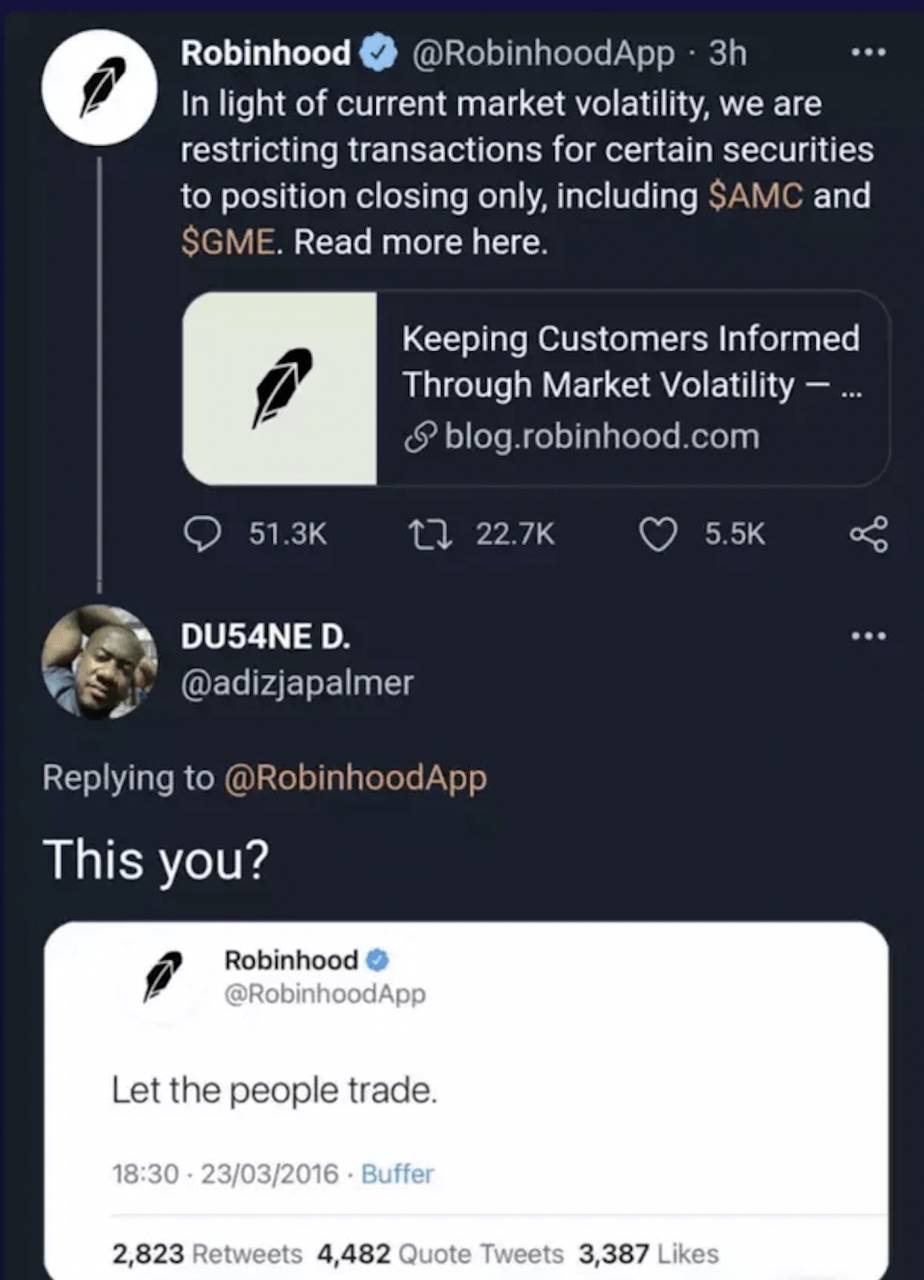
Millions of retail investors felt that Robinhood had betrayed its promise of "financial democratization," criticizing it for bowing to Wall Street forces. There were even conspiracy theories accusing Robinhood of colluding with Citadel Securities (its largest order flow partner) to manipulate the market in order to protect hedge fund interests.
Online harassment, death threats, and a barrage of negative reviews followed. Robinhood suddenly transformed from a "friend of retail investors" to a target of public ire, forcing Tenev and his family to go into hiding and hire private security.
On January 29, Robinhood announced it had urgently raised $1 billion to maintain operations, followed by several rounds of financing, ultimately raising a total of $3.4 billion. Meanwhile, lawmakers, celebrities, and public opinion relentlessly pursued the company.
On February 18, Tenev was summoned to testify at a U.S. Congressional hearing, where he insisted that Robinhood's decision was due to settlement pressures and had nothing to do with market manipulation.
Despite this, the doubts never subsided. The Financial Industry Regulatory Authority (FINRA) launched a thorough investigation into Robinhood, ultimately imposing the largest single fine in history—$70 million, which included a $57 million penalty and $13 million in customer compensation.
The GameStop incident became a turning point in Robinhood's history.
This financial storm severely damaged Robinhood's image as a "protector of retail investors," and its brand reputation and user trust suffered significant blows. For a time, Robinhood became a "survivor in the cracks," both unsatisfactory to retail investors and under scrutiny from regulators.
However, this incident also prompted U.S. regulatory agencies to begin reforming the clearing system, pushing to shorten the settlement cycle from T+2 to T+1, bringing long-term impacts to the entire financial industry.
After this crisis, Robinhood advanced its long-prepared IPO.
On July 29, 2021, Robinhood went public on NASDAQ under the ticker "HOOD," with an offering price set at $38, valuing the company at approximately $32 billion.
However, the IPO did not bring Robinhood the anticipated capital feast. On its first day of trading, the stock price opened lower and ultimately closed at $34.82, down 8% from the offering price. Although there was a brief rebound due to retail investor enthusiasm and institutional buying (such as from ARK Invest), the overall trend remained under pressure for a long time.
The divide between Wall Street and the market was evident—whether to view it as a "financial gateway for the retail investor era" or to worry about its controversial business model and future regulatory risks.
Robinhood stood at the crossroads of trust and skepticism, officially entering the reality test of the capital market.
But at that moment, few noticed a signal hidden in the lines of the prospectus—the word "Crypto" was mentioned 318 times in the S-1 document submitted by Robinhood.
This unintentional high frequency hinted at a declaration of strategic shift.
Crypto was the new narrative that Robinhood quietly unveiled.
Hitting Crypto
As early as 2018, Robinhood had quietly ventured into the cryptocurrency business, being one of the first to offer trading services for Bitcoin and Ethereum. At that time, this move seemed more like a product line supplement and had not yet become a core strategy.
But market enthusiasm quickly changed everything.
In 2021, The New Yorker described Robinhood as: "a zero-commission platform that offers both stocks and cryptocurrency trading, dedicated to becoming an enlightened version of Wall Street, tasked with the mission of 'achieving financial democratization for all.'"
The growth in data also confirmed the potential of this track:
In the fourth quarter of 2020, approximately 1.7 million users traded cryptocurrencies on the Robinhood platform, and by the first quarter of 2021, this number skyrocketed to 9.5 million, a quarterly increase of over 5 times.
In the first quarter of 2020, cryptocurrency trading revenue accounted for about 4% of the company's total trading revenue. By the first quarter of 2021, this figure surged to 17%, and in the second quarter, it exploded to 41%.
Starting from 2019, Robinhood's cryptocurrency asset scale was only $4.15 million. By the end of 2020, this number had skyrocketed to $35.27 million, an increase of over 750%. Entering the first quarter of 2021, the managed scale soared to $1.16 billion, a year-on-year increase of over 2,300%.

At this moment, cryptocurrency had transformed from a marginal product into one of Robinhood's revenue pillars, clearly positioned as a growth engine. As they wrote in their documents: "We believe that cryptocurrency trading opens up new space for our long-term growth."
But what exactly happened that led to the explosive growth of Robinhood's cryptocurrency business in just one or two quarters?
The answer also appeared in the S-1 prospectus. Remember the crazy Dogecoin phenomenon in 2021? Robinhood was a driving force behind the Dogecoin wave.
The S-1 document clearly stated: "In the three months ending June 30, 2021, 62% of cryptocurrency trading revenue came from Dogecoin, compared to 34% in the previous quarter."
To meet user demand, Robinhood announced in August 2021 plans to launch cryptocurrency deposit and withdrawal features, allowing users to freely transfer assets like Bitcoin, Ethereum, and Dogecoin in and out of their wallets.
Six months later, at the LA Blockchain Summit, Robinhood officially released the test version of the multi-chain Robinhood Wallet, which was made available to iOS users in September 2022 and fully launched in 2023.
This move marked the beginning of Robinhood's transformation from a "centralized broker" to a "digital asset platform."
However, just as Robinhood was accelerating its transformation amid the crypto boom, a rather legendary figure had set his sights on it—Sam Bankman-Fried (SBF).
The then-prominent founder and CEO of FTX was known for his aggressive expansion tactics and disruptive ambitions in the financial industry.
In May 2022, SBF quietly acquired about 7.6% of Robinhood's shares through his holding company Emergent Fidelity Technologies, valued at approximately $648 million.
After the news broke, Robinhood's stock price surged over 30% in after-hours trading.
In the 13D document submitted to the U.S. Securities and Exchange Commission (SEC), SBF stated that he bought into Robinhood because he "considered it an attractive investment," and promised that he was not currently seeking control or intervention in management. However, the document also retained the statement that "future intentions regarding shareholding may be adjusted based on circumstances," leaving ample room for maneuver.

In reality, SBF's move was difficult to interpret simply as a financial investment.
At that time, FTX was actively laying out its compliance in the U.S. market, trying to shed its identity as a "pure cryptocurrency exchange" and penetrate traditional finance and securities business. Robinhood, with its vast retail user base and compliance qualifications, was the ideal bridge.
There were widespread rumors that SBF intended to push for deeper cooperation with Robinhood, even attempting a merger, although SBF publicly denied this rumor, he never ruled out the possibility for the future.
However, SBF's layout did not lead to the ideal "win-win."
By the end of 2022, FTX collapsed, and SBF was embroiled in allegations of fraud, money laundering, and financial crimes. In January 2023, the U.S. Department of Justice officially seized approximately 56 million shares of Robinhood stock held by SBF through his holding company, valued at about $465 million at the time.
This stake, which originally symbolized a "crypto-financial alliance," ultimately became a hot potato of legal evidence.
It wasn't until September 1, 2023, that Robinhood repurchased this batch of shares from the U.S. Marshals Service (USMS) for $605.7 million, completely resolving the potential holding risk.
Ironically, based on Robinhood's current market value of $86 billion, the 7.6% stake that SBF once held would have risen to about $6.5 billion today, more than ten times its original cost.
It turned out that this "attractive investment" that SBF believed was indeed very enticing.
Take Off, Stock Price
If the GameStop incident was a baptism of crisis for Robinhood, then 2025 marked the official arrival of its shining moment.
All of this had long been foreshadowed.
In the fourth quarter of 2024, Robinhood's key metrics hit new highs:
Managed assets, net deposits, Gold subscription users, revenue, net profit, adjusted EBITDA, and earnings per share all exceeded expectations;
Quarterly revenue surpassed $1.01 billion, net profit reached $916 million, Gold subscription users exceeded 2.6 million, and adjusted EBITDA reached $613 million…
Cryptocurrency trading volume surged to $71 billion, with cryptocurrency business revenue growing 700% year-on-year, generating $358 million in a single quarter.
Notably, in the fourth-quarter earnings report, Robinhood founder Tenev stated: "We see the tremendous opportunity in front of us, because we are working to enable anyone, anywhere, to buy, sell, or hold any financial asset and conduct any financial transaction through Robinhood."
This is probably a small foreshadowing.
On February 14, 2025, just two days after the earnings report was released, Robinhood's stock price reached its first peak of 2025 at $65.28.
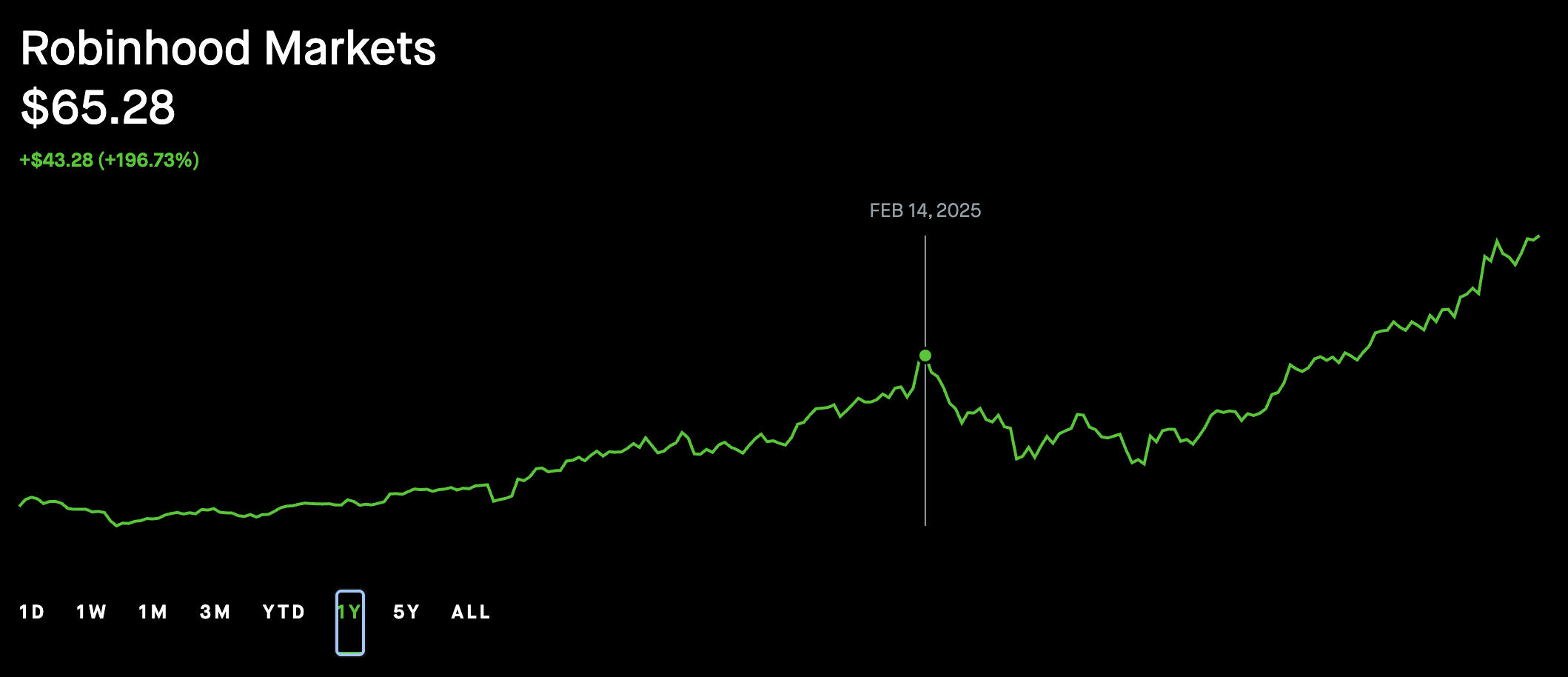
But what truly ignited this stock price surge was the resonance between the global financial and cryptocurrency markets.
With Trump's election and the U.S. policy shifting to be "crypto-friendly," the regulatory risks for Robinhood gradually diminished.
On February 21, 2025, the U.S. SEC's enforcement division officially notified Robinhood Crypto, ending a year-long investigation into its cryptocurrency business, custody processes, and payment order flow, and decided not to take any enforcement action. This letter not only cleared the policy obstacles for Robinhood's future expansion in the cryptocurrency business but also became an important catalyst for the stock price's breakthrough rebound.
Shortly thereafter, Robinhood delivered a powerful blow.
On June 2, 2025, Robinhood officially announced the completion of its acquisition of Bitstamp, one of the world's oldest cryptocurrency exchanges, for $65 million.
Bitstamp was renamed "Bitstamp by Robinhood," fully integrating into Robinhood Legend and Smart Exchange Routing systems. This strategic acquisition not only provided Robinhood with compliant assets and a ticket to the global market but also propelled it from a retail brokerage to compete alongside Coinbase and Binance in the global cryptocurrency exchange arena.
The next day, the stock price broke through $70.
If the Bitstamp acquisition was an important step for Robinhood's international expansion, the subsequent actions announced Robinhood's bold entry into the Web3 capital market.
Remember Tenev's earlier forecast? "Anyone, anytime, any financial asset, any transaction takes a step further."
On June 30, 2025, Robinhood announced its official entry into the blockchain securities field, allowing European users to trade over 200 U.S. stocks and ETFs on the Arbitrum network using blockchain-based tokens, including stocks from well-known companies like Nvidia, Apple, and Microsoft.
Moreover, Robinhood also unveiled its development plan for its self-developed Layer-2 blockchain, "Robinhood Chain."
The market reacted positively, with Robinhood's stock price surging in a single day, achieving a monthly increase of 46%, and on July 2, it broke through $100 during trading, setting a new historical high.
Although the market experienced a brief pullback due to rumors about OpenAI's tokenization being debunked, analysts generally believe that Robinhood has successfully transformed from a "retail brokerage" to a "fintech platform," with blockchain securities set to become its next long-term growth engine.
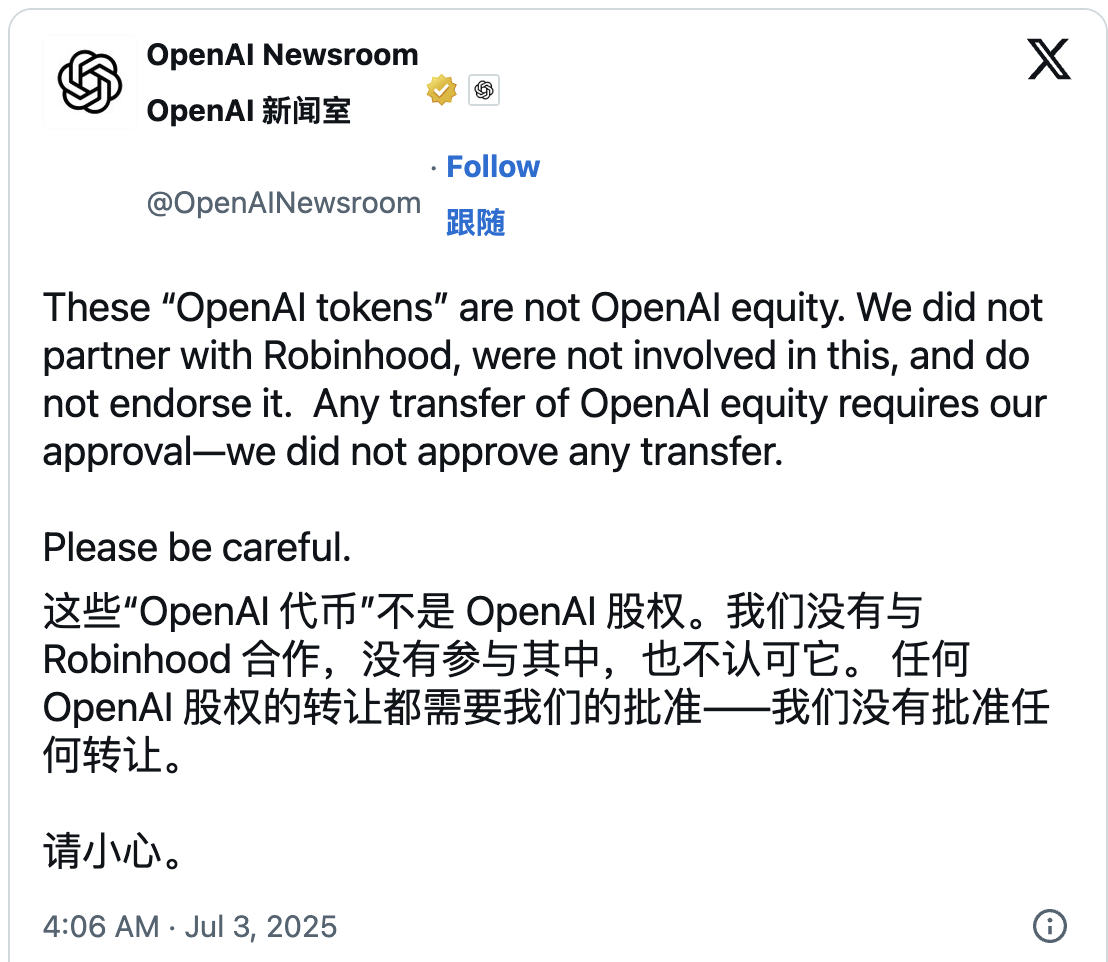
As of now, Robinhood's stock price remains firmly around $100, with an annual increase of nearly 150%, and its market value surpassing $88 billion (approximately 630 billion RMB), far exceeding expectations at the time of its IPO.
From grassroots to today, Robinhood, with a market value of $86.7 billion, is no longer what it once was. From being the "target of public ire" during the GameStop storm in 2021 to becoming a trendsetter in the wave of financial and crypto integration in 2025, Robinhood has not only endured the extreme tests of the capital market but has also completed its accelerated reconstruction in five years.
If history chose Robinhood back then, at this moment, Robinhood has finally become a player capable of leading history.
Today, Tenev can probably tell his college self, who worried about mathematics as a career: "You also spent years exploring a specific problem, and at least you didn't come away empty-handed."
免责声明:本文章仅代表作者个人观点,不代表本平台的立场和观点。本文章仅供信息分享,不构成对任何人的任何投资建议。用户与作者之间的任何争议,与本平台无关。如网页中刊载的文章或图片涉及侵权,请提供相关的权利证明和身份证明发送邮件到support@aicoin.com,本平台相关工作人员将会进行核查。




